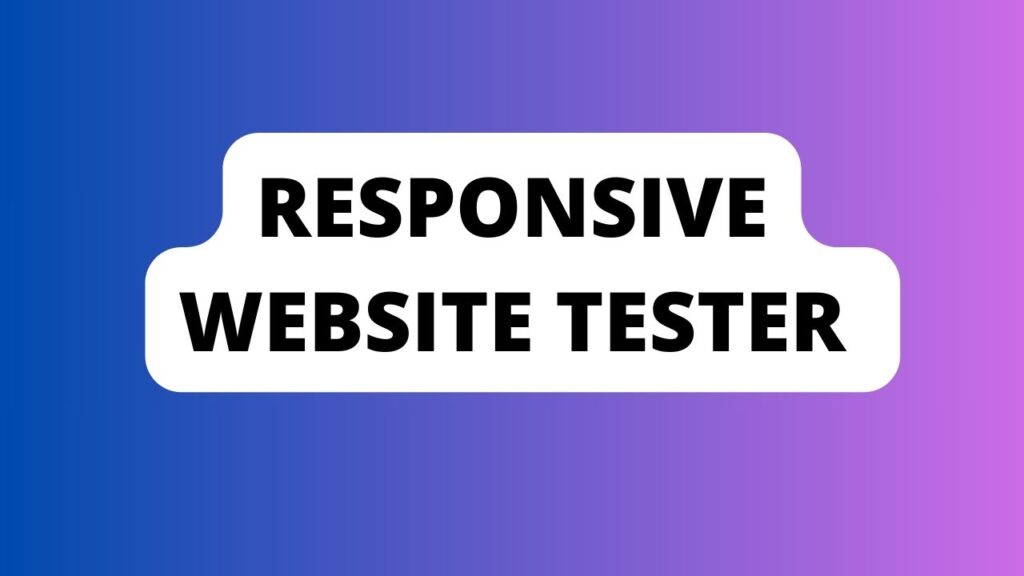Introduction
Responsive Website Tester In today’s digital landscape, where online presence is paramount, ensuring a seamless user experience across various devices is non-negotiable. Responsive Website Tester tools play a pivotal role in achieving this, making websites adaptable to different screen sizes and devices. Let’s delve deeper into the world of Responsive Website Testing and its crucial role in optimizing online experiences.
Understanding Responsive Design
What is Responsive Design? Responsive Design refers to the approach of creating websites that dynamically adjust and adapt their layout and content based on the device being used. It ensures optimal viewing and interaction experiences across a wide range of devices, from desktops to smartphones and tablets.
Principles of Responsive Design The foundation of Responsive Design lies in flexibility, fluid grids, and media queries. These principles enable websites to resize, reformat, and optimize content presentation, maintaining usability and accessibility.
Benefits of Responsive Design Responsive Design goes beyond aesthetics; it enhances user experience, boosts SEO rankings, simplifies maintenance, and amplifies reach by catering to diverse user preferences.
Importance of Responsive Website Testing
Impact on User Experience A responsive website significantly impacts user engagement and satisfaction. Testing ensures consistent usability, faster load times, and content accessibility across devices, fostering positive user interactions.
SEO Benefits Search engines favor responsive websites, considering them user-friendly and providing higher search rankings. Thorough testing helps maintain SEO integrity, ensuring visibility across search engine result pages (SERPs).
Business Implications For businesses, a responsive website translates into increased conversions, reduced bounce rates, and amplified brand credibility. Effective testing guarantees a competitive edge and improved customer retention.
Responsive Website Tester Tools
Types of Tools Available Responsive Website Tester tools come in various forms, including online platforms, browser extensions, and integrated development environments (IDEs). Each type offers distinct features catering to different testing needs.
Features to Look For Efficient tools encompass features like device emulation, screen resolution adjustments, performance testing, and cross-browser compatibility checks. These attributes ensure comprehensive testing coverage.
Popular Responsive Website Testing Tools Leading tools such as Google’s Mobile-Friendly Test, BrowserStack, and Responsinator are widely used for their reliability, accuracy, and extensive testing capabilities.

How Responsive Testing Works
Testing Methodologies Responsive Testing involves examining website behavior across devices, browsers, and resolutions. It employs automated and manual testing techniques to identify inconsistencies and rectify them.
Key Testing Parameters Testers focus on layout, navigation, images, content readability, and functionality across various devices to ensure a consistent and seamless user experience.
Common Challenges Challenges in responsive testing include device fragmentation, browser inconsistencies, and complex design elements. Rigorous testing addresses these challenges to deliver a flawless website experience.
Best Practices in Responsive Testing
Strategies for Effective Testing Adopting a device-agnostic approach, prioritizing performance, leveraging automated testing tools, and conducting real user tests are vital strategies for effective testing.
Addressing Common Issues Addressing issues like image optimization, flexible grids, and content prioritization optimizes website responsiveness and resolves common testing pitfalls.
Continuous Improvement Responsive testing is an ongoing process. Regular updates, user feedback incorporation, and staying abreast of technological advancements ensure sustained website excellence.
Case Studies
Successful Implementations Case studies showcasing successful responsive website implementations highlight improved user engagement, reduced bounce rates, and enhanced conversions.
Challenges Faced and Resolved Real-life examples of challenges faced during responsive testing and their resolutions offer insights into overcoming obstacles and achieving optimal results.
Impact on Business Measurable impacts on businesses post-responsive testing underscore the correlation between website excellence and business success.
Responsive Website Tester Certification
Importance for Professionals Certifications in Responsive Website Testing validate expertise and proficiency, enhancing professional credibility and opening doors to career advancement.
Best Certification Programs Reputable certification programs like Google Mobile Web Specialist and W3C’s Responsive Web Design offer comprehensive training and recognition.
Career Opportunities Certified professionals can explore diverse roles such as Responsive Design Specialist, QA Tester, or Web Developer, in high-demand sectors.
Conclusion
Responsive Website Tester tools are indispensable in ensuring a website’s adaptability and excellence in a diverse digital landscape. Embracing responsive testing not only enhances user experience and SEO but also propels businesses towards growth and success.
FAQs
What is the significance of responsive design in today’s digital world? Responsive design ensures optimal user experience across devices, catering to the evolving preferences of users accessing websites from various platforms.
How does responsive website testing impact SEO? Responsive websites rank higher in search engine results, as they offer better user experiences, aligning with search engines’ preferences for user-friendly websites.
Can responsive testing tools guarantee a perfect website across all devices? While responsive testing tools enhance website performance, achieving perfection across all devices requires continual testing, refinement, and adaptation.
Is a mobile-first approach essential in responsive testing strategies? Adopting a mobile-first approach ensures prioritizing mobile users, optimizing for smaller screens, and progressively enhancing the website for larger devices.
What role does user experience play in responsive testing? User experience is pivotal; responsive testing focuses on metrics like load times, navigation ease, and content accessibility to ensure an engaging user journey.
What are the predicted future trends in responsive testing? Future trends include AI-driven testing, IoT integration, and more advanced tools catering to the evolving landscape of digital devices.
